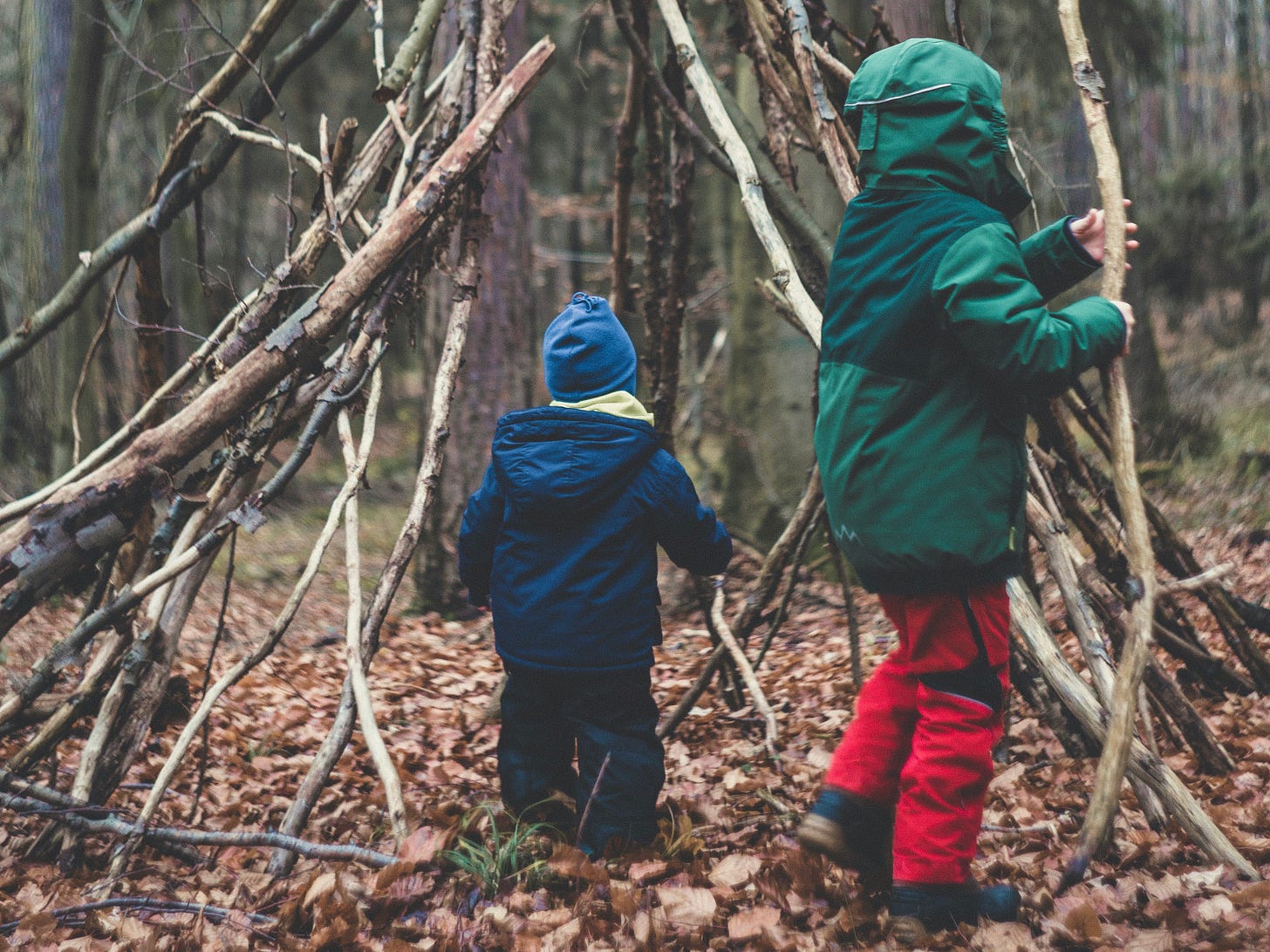7 Small Thoughts on Kids' Nature Play
Some parenting lessons from Richard Louv's book, "Last Child in the Woods"
I hauled my kids out for a hike this past weekend. It was a beautiful sunny Saturday, and even though there were a dozen chores needing to be done at home—laundry, floors, groceries, garden mulching—I wanted us to get outside together. The older one protested, but as soon as we got out of the house and started moving, I could tell he started to enjoy himself.
It can feel difficult to break out of routine and make time for outdoor play and exploration, but it’s hugely important. I often think about Richard Louv’s fantastic book, Last Child in the Woods, which had a profound influence on my parenting philosophy. (I had the privilege of interviewing him for my own book, Childhood Unplugged.)
In a recent reread of the book, I was struck by some of the lessons Louv offered to parents when it comes to the hows and whys of getting kids out into nature. I wanted to share some of these with you today.
Nature Time = Health Time
Nature experiences “should be taken out of the leisure column and put in the health column,” Louv writes. In other words, we need to stop thinking about outdoor play as a nice-to-have and more of a necessity, an integral part of a child’s daily life. If we started thinking of outdoor play as integral in the way that good nutrition and sufficient sleep are, we’d have much happier kids.
Don’t Watch the Clock
Ideally, nature play should take on a sense of timelessness. Louv says, “It takes time—loose, unstructured dreamtime—to experience nature in a meaningful way.” Don’t look at the time; instead, let curiosity propel you forward and deeper. Let your child set the pace and follow behind. Allow a young child the time they need to investigate an anthill or a stream. If it means you only travel a few dozen feet in the time you’re outside, consider it a success.
Look for the Edges
This is advice I’d never considered before reading Louv’s book. He points out that nature intensifies at the places where habitats meet. That’s where it is most interesting for people to explore. “Where the trees stop and a field begins; where rocks and earth meet water; life is always at the edges.” Look more closely next time and you’ll see this is true.
Accept Some Destruction
A child engaging in a natural habitat will inevitably wreak some havoc—broken sticks, trampled plants, overturned rocks, plucked wildflowers. That’s OK. Consider it training for the future stewards of the earth. I love this quote from David Sobel, education expert, who uses the example of treehouses.
“[Treehouses] undeniably damage the tree, but that occasional damage to a tree is not as important as what children learn when playing in that tree.”
Create Space for Wonder
While identification and naming can be satisfying in certain situations to certain people, it does not belong in free play and exploration. Resist the urge to turn a nature walk into an educational experience for your child, which can create a “know-it-all state of mind [with] the accompanying loss of wonder.” Just let them roam, look, absorb on their own—and most importantly, feel amazed by what they’re seeing.
Don’t Fret About Safety
Step back and take a deep breath. Count to 17 (the magic number!) if you need to. Hold back before issuing warnings or exclamations of concern. Let the child test their own limits and self-regulate, if possible, so that they do not have to grow up in “the un-brave new world.” Be present-ish, but out of the way, able to be summoned in an emergency that is unlikely to arrive. Familiarize yourself with the necessity of risky play.
Make Nature a Religious Practice
A concept I talked about in my book: There are many parents who take their kids to church every week out of a sense of moral obligation. (Mine did.) We should view time in nature in a similar vein, practicing it with the same level of commitment, as something we know makes our children better, happier, more rooted individuals. We parents should understand that we have a responsibility to maximize outdoor time because of the profound benefits it offers every child.
You Might Also Like:
Move With Purpose
The Art of Family Dinner
Big Things Don’t Cancel Out Little Things
A Note on Subscriptions:
If you appreciate my work, please forward my essays to someone who may enjoy them, and consider becoming a paid subscriber. My dream is for this newsletter to become a self-sustaining project, and reader subscriptions are the only way to make that possible!
I also give talks on digital minimalism to schools and community groups, so reach out if you’d like me to speak. Learn more on my website.





If you are Christian, nature walks with kids are already religious practice - it's family worship! Great tips.
beautiful, thank you